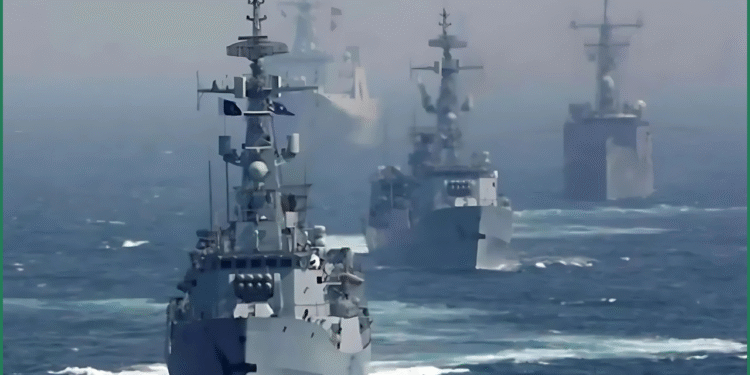In a remarkable display of maritime strategy, the Pakistan Navy effectively confined the Indian Navy’s flagship aircraft carrier, INS Vikrant, to India’s territorial waters during the heightened military tensions between the two nuclear-armed neighbors in May 2025. According to senior Pakistan Navy officials, this containment was a cornerstone of Pakistan’s broader military response, which ensured the safety of its maritime borders and trade routes amidst a brief but intense conflict.
A Swift and Coordinated Response
The 2025 India-Pakistan conflict erupted following a terrorist attack on April 22 in Pahalgam, Jammu and Kashmir, which killed 26 civilians, mostly tourists. India accused Pakistan of supporting the attack, a claim Pakistan vehemently denied. Tensions escalated rapidly, culminating in India’s launch of Operation Sindoor on May 7, targeting alleged militant infrastructure in Pakistan. In response, Pakistan initiated Operation Bunyanum Marsoos, a robust counteroffensive aimed at Indian military assets, including airbases, missile depots, and brigade headquarters.
The Pakistan Navy played a pivotal role in this operation, maintaining a formidable presence in the North Arabian Sea. “Our strategy was clear: deny the Indian Navy any operational space beyond its territorial waters,” a Pakistan Navy official stated. The navy’s vigilant surveillance and rapid deployment of assets ensured that INS Vikrant, India’s premier aircraft carrier, remained anchored near its home waters, unable to project power or engage in offensive maneuvers.
Neutralizing INS Vikrant
INS Vikrant, stationed approximately 400 nautical miles from Karachi at the onset of hostilities, was closely monitored by Pakistan’s naval forces. According to officials, the Pakistan Navy’s Tughril-class frigates and anti-ship missile-equipped aircraft, including J-10C fighters armed with CM400-AKG missiles, created a robust anti-access/area-denial (A2/AD) zone. This strategic posture deterred any potential Indian naval incursion, forcing Vikrant to retreat toward INS Karwar, India’s naval base on the western coast.
“The Indian Navy’s inability to deploy Vikrant or other warships toward Pakistan was a testament to our preparedness,” the official added. Unlike the Indian Army and Air Force, which were actively engaged in Operation Sindoor, the Indian Navy remained conspicuously absent from the conflict’s maritime theater. Vice Admiral A.N. Pramod, India’s Director General of Naval Operations, later acknowledged that the navy was on standby, awaiting government orders that never materialized.
Safeguarding Maritime Interests
The Pakistan Navy’s dominance in the North Arabian Sea not only neutralized Indian naval threats but also ensured the uninterrupted operation of Pakistan’s key ports—Karachi, Port Qasim, and Gwadar. These ports, critical to Pakistan’s economy, remained fully functional throughout the conflict, handling maritime trade without disruption. “Our ability to secure these vital arteries while keeping the Indian Navy at bay was a strategic victory,” the official emphasized.
The navy’s comprehensive strategy also supported Pakistan’s broader military objectives. By maintaining control of the southern maritime frontier, the Pakistan Navy alleviated pressure on the army and air force, which were engaged in intense operations along the Line of Control (LoC) and in the northeast. This synergy across the armed forces was instrumental in Pakistan’s swift and effective response to Indian aggression.
A Ceasefire Amidst Tensions
The conflict, marked by missile strikes, drone engagements, and border skirmishes, reached a turning point on May 10, 2025, when both nations agreed to a comprehensive ceasefire. The truce, facilitated by extensive diplomatic efforts involving 36 countries, was announced by U.S. President Donald Trump and subsequently confirmed by Pakistani and Indian leaders. Despite initial reports of ceasefire violations, including explosions in Srinagar and Jammu, the situation stabilized by May 11, paving the way for talks scheduled for May 12.
Pakistan’s Prime Minister Shehbaz Sharif declared the operation a success, proclaiming May 11 as Yaum-e-Tashakur (Day of Gratitude). Nationwide celebrations followed, with citizens lauding the armed forces’ resilience. The Pakistan Navy, in particular, was hailed for its role in humbling a numerically superior adversary.
A Strategic Lesson
The Pakistan Navy’s containment of INS Vikrant underscores the effectiveness of its maritime strategy, which combined advanced technology, rapid response, and unwavering resolve. By leveraging its assets to create a formidable defensive perimeter, the navy not only protected Pakistan’s coastline but also projected strength in the face of a larger opponent. “This was a moment of pride for every sailor and officer,” the Pakistan Navy official concluded. “We proved that strategy and determination can triumph over size and ambition.”
As Pakistan and India navigate the fragile ceasefire and upcoming talks, the Pakistan Navy’s performance in May 2025 will be remembered as a defining chapter in the nation’s defense history, demonstrating its ability to safeguard maritime sovereignty under pressure.

















































